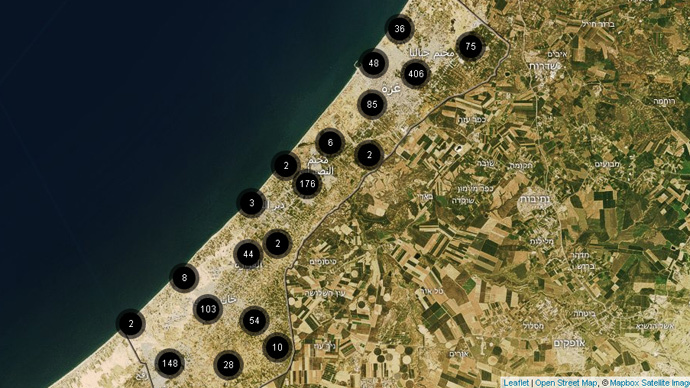AI's press release announcing the launch states the "purpose is to help push for accountability for war crimes and other violations of international humanitarian law." The platform is an extraordinarily ambitious collaboration and is available to anyone, researchers, journalists, and activists alike.
From AI's press release: Launch of innovative digital tool to help expose patterns of Israeli violations in Gaza
The preliminary data currently plotted on the Platform, which will be updated over the coming months, already highlights a number of patterns in the attacks by Israeli forces that indicate that grave and systemic violations were committed.Readers may recall Forensic Architecture's outstanding efforts in exposing the murders of 17-year-old Nadeem Nawara and 16-year-old Mohammad Abu Daher, The Nakba Day denial. Their partnership with Amnesty International in providing this tool, effectively creates the opportunity for each one of us, including scientific researchers and analysts, to be part of the effort to hold Israel accountable and end these horrendous crimes against humanity which are gross violations of International law.
"The Gaza Platform is the most comprehensive record of attacks during the 2014 conflict to date. It allows us to piece together more than 2,500 individual attacks, illustrating the vast scale of destruction caused by Israel's military operations in Gaza during the 50-day war last summer," said Philip Luther, Director of Amnesty International's Middle East and North Africa Program.
"By revealing patterns rather than just presenting a series of individual attacks, the Gaza Platform has the potential to expose the systematic nature of Israeli violations committed during the conflict. Our aim is for it to become an invaluable resource for human rights investigators pushing for accountability for violations committed during the conflict."
How the Gaza Platform works
The Platform records the time and location of each attack on an interactive map and classifies it according to numerous criteria including type of attack, site struck and number of casualties to highlight patterns. Photos, videos, eyewitness testimony and satellite imagery for attacks are also included where available. With the help of new data visualization and digital mapping technology, users can view and search this information to detect patterns in the Israeli forces' conduct during the conflict. The aim is to identify and publicize patterns which can help in the analysis of whether particular attacks constitute violations of international humanitarian law, including war crimes.
A team of researchers in London and Gaza has been working over several months to collate and input onto the Platform data collected on the ground by the Gaza-based human rights organizations Al Mezan and the Palestinian Center for Human Rights (PCHR), as well as information gathered by Amnesty International.
The launch of the Platform is just the start of the project - it will be updated with new information as work to gather further evidence relating to the conflict continues.
Patterns of Israeli violations
While a vast amount of multimedia information, including testimony, photos, videos and satellite imagery, is still being processed, the Gaza Platform currently shows that more than 270 Israeli attacks were carried out using artillery fire during the 2014 conflict, killing more than 320 civilians. The repeated use of artillery, an imprecise explosive weapon, in densely populated civilian areas constitutes indiscriminate attacks that should be investigated as war crimes.
The Platform also clearly illustrates an overwhelming pattern of targeting residential homes, with more than 1,200 Israeli attacks on houses resulting in more than 1,100 civilian deaths. Direct attacks on civilians not directly participating in hostilities and on civilian objects are prohibited under international humanitarian law, or "the laws of war." Amnesty International, the UN Commission of Inquiry and other conflict monitoring organizations have raised the alarm about the high number of such attacks during the 2014 conflict.
Users can also note other disturbing patterns, such as Israeli attacks striking first responders, medical workers and facilities, as well as the extensive use of "knock on the roof" warning attacks, where a missile fired from a drone is followed shortly afterwards by a larger bomb. Amnesty International does not consider that such strikes constitute an effective warning, nor do they absolve Israel from the clear obligation not to direct attacks at civilians or civilian property.
The video above was released in conjunction with Gaza Platform's launch. We recommend.




Reader Comments
6. The Ring of Power